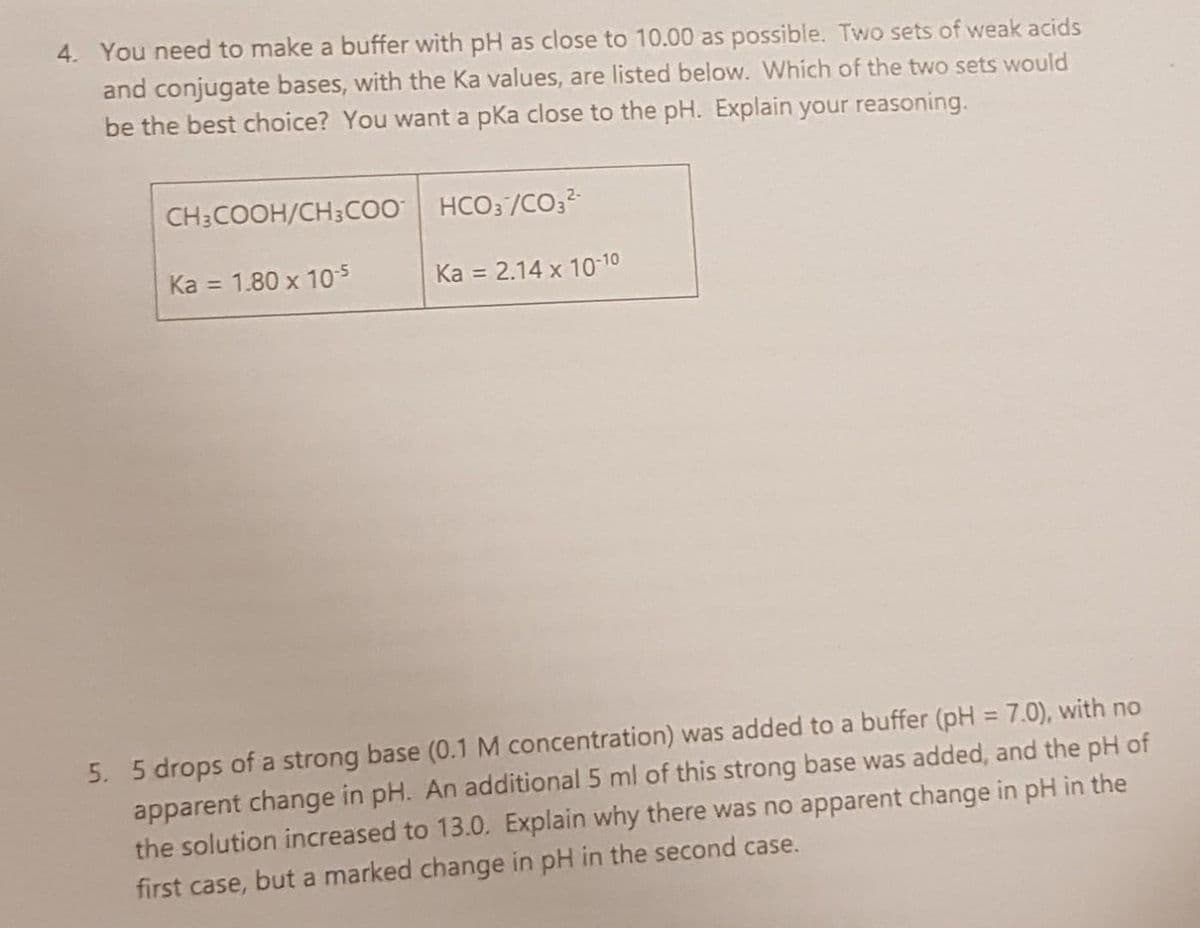4. You need to make a buffer with pH as close to 10.00 as possible. Two sets of weak acids and conjugate bases, with the Ka values, are listed below. Which of the two sets would be the best choice? You want a pKa close to the pH. Explain your reasoning. CH3COOH/CH3COO HCO3 /CO;? Ka = 1.80 x 105 Ka = 2.14 x 10-10
4. You need to make a buffer with pH as close to 10.00 as possible. Two sets of weak acids and conjugate bases, with the Ka values, are listed below. Which of the two sets would be the best choice? You want a pKa close to the pH. Explain your reasoning. CH3COOH/CH3COO HCO3 /CO;? Ka = 1.80 x 105 Ka = 2.14 x 10-10
Chemistry & Chemical Reactivity
9th Edition
ISBN:9781133949640
Author:John C. Kotz, Paul M. Treichel, John Townsend, David Treichel
Publisher:John C. Kotz, Paul M. Treichel, John Townsend, David Treichel
Chapter17: Principles Of Chemical Reactivity: Other Aspects Of Aqueous Equilibria
Section: Chapter Questions
Problem 15PS: A buffer is composed of formic acid and its conjugate base, the formate ion. (a) What is the pH of a...
Related questions
Question

Transcribed Image Text:4. You need to make a buffer with pH as close to 10.00 as possible. Two sets of weak acids
and conjugate bases, with the Ka values, are listed below. Which of the two sets would
be the best choice? You want a pka close to the pH. Explain your reasoning.
CH:COOH/CH;coo HCO; /CO,2-
Ka = 1.80 x 10s
Ka = 2.14 x 10-10
%3D
%3D
5. 5 drops of a strong base (0.1 M concentration) was added to a buffer (pH = 7.0), with no
apparent change in pH. An additional 5 ml of this strong base was added, and the pH of
the solution increased to 13.0. Explain why there was no apparent change in pH in the
%3D
first case, but a marked change in pH in the second case.
Expert Solution
This question has been solved!
Explore an expertly crafted, step-by-step solution for a thorough understanding of key concepts.
This is a popular solution!
Trending now
This is a popular solution!
Step by step
Solved in 4 steps

Knowledge Booster
Learn more about
Need a deep-dive on the concept behind this application? Look no further. Learn more about this topic, chemistry and related others by exploring similar questions and additional content below.Recommended textbooks for you

Chemistry & Chemical Reactivity
Chemistry
ISBN:
9781133949640
Author:
John C. Kotz, Paul M. Treichel, John Townsend, David Treichel
Publisher:
Cengage Learning

Chemistry & Chemical Reactivity
Chemistry
ISBN:
9781337399074
Author:
John C. Kotz, Paul M. Treichel, John Townsend, David Treichel
Publisher:
Cengage Learning

Chemistry: An Atoms First Approach
Chemistry
ISBN:
9781305079243
Author:
Steven S. Zumdahl, Susan A. Zumdahl
Publisher:
Cengage Learning

Chemistry & Chemical Reactivity
Chemistry
ISBN:
9781133949640
Author:
John C. Kotz, Paul M. Treichel, John Townsend, David Treichel
Publisher:
Cengage Learning

Chemistry & Chemical Reactivity
Chemistry
ISBN:
9781337399074
Author:
John C. Kotz, Paul M. Treichel, John Townsend, David Treichel
Publisher:
Cengage Learning

Chemistry: An Atoms First Approach
Chemistry
ISBN:
9781305079243
Author:
Steven S. Zumdahl, Susan A. Zumdahl
Publisher:
Cengage Learning

Chemistry
Chemistry
ISBN:
9781305957404
Author:
Steven S. Zumdahl, Susan A. Zumdahl, Donald J. DeCoste
Publisher:
Cengage Learning


Principles of Modern Chemistry
Chemistry
ISBN:
9781305079113
Author:
David W. Oxtoby, H. Pat Gillis, Laurie J. Butler
Publisher:
Cengage Learning